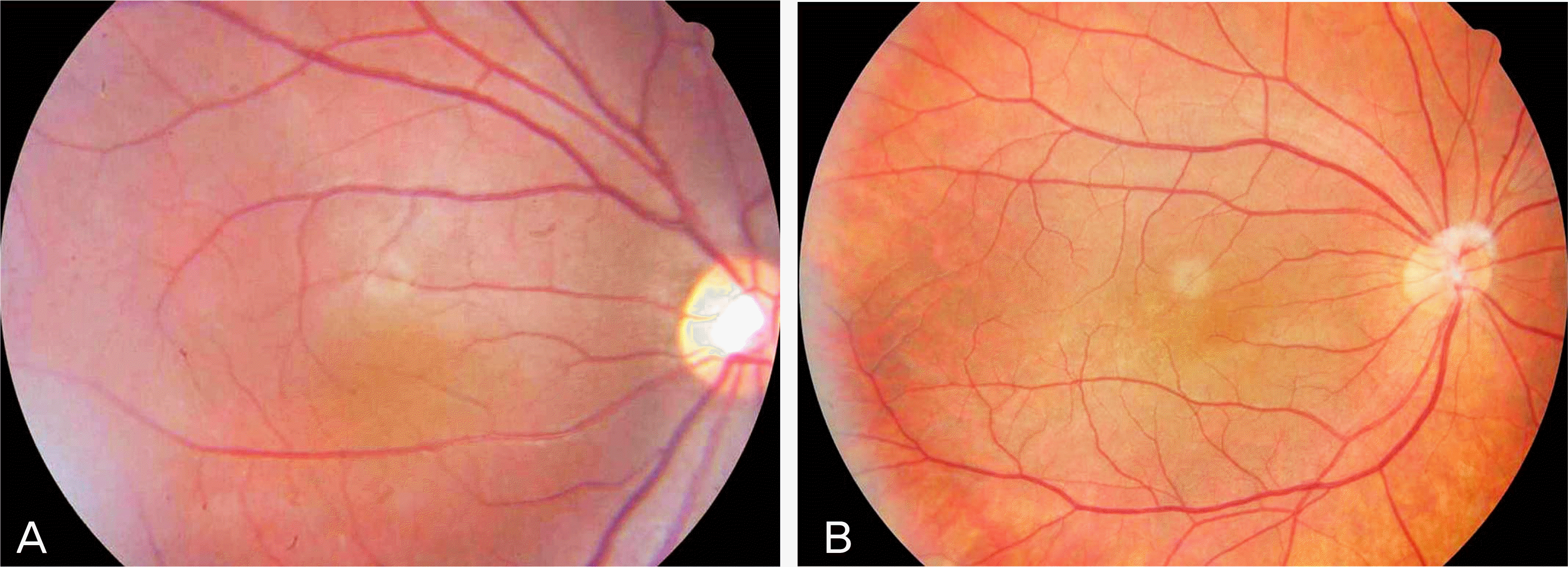Abstract
Purpose
To estimate the baseline demographic/ocular characteristics and associated findings of patients with foveal hypoplasia.
Methods
The medical records of 42 patients (84 eyes) who were clinically diagnosed with foveal hypoplasia were retrospectively reviewed.
Results
There were 28 males and 14 females with mode age at diagnosis of 1 (range, 0-60 years) year and a mean followup period of 9.7 ± 5.4 years. At the first office visit, the most common complaints were ocular oscillation and face turn. There were 75 eyes (91.5%) with best corrected visual acuity worse than 0.3 at the first visit, but that number decreased to 55 eyes (67.1%) at the last followup (age range, 7-60 years). The absolute spherical equivalent of refractive errors was 2.89 ± 2.96 diopters (D), and 71 eyes had astigmatism with a mean astigmatism of 2.1 ± 1.1 D. Forty-two patients had associated diseases: 15 (35.7%) with aniridia, 16 (38.1%) with ocular albinism and 11 (26.2%) with oculocutaneous albinism. In addition, strabismus was found in 24 patients (57.1%).
Conclusions
Diseases associated with foveal hypoplasia include aniridia, ocular albinism and oculocutaneous albinism. Since foveal hypoplasia is often associated with high refractive errors and poor vision, an early prescription of eyeglasses is mandatory for management of refractive amblyopia to ensure the development of the best corrected visual acuity.
Go to : 
References
1. Oliver MD, Dotan SA, Chemke J, Abraham FA. Isolated foveal hypoplasia. Br J Ophthalmol. 1987; 71:926–30.

2. Vincent A, Kemmanu V, Shetty R, et al. Variable expressivity of ocular associations of foveal hypoplasia in a family. Eye (Lond). 2009; 23:1735–9.

3. Summers CG, Knobloch WH, Witkop CJ Jr, King RA. Hermansky-Pudlak syndrome. Ophthalmic findings. Ophthalmology. 1988; 95:545–54.
5. Holmstrom G, Eriksson U, Hellgren K, Larsson E. Optical coherence tomography is helpful in the diagnosis of foveal hypoplasia. Acta Ophthalmol. 2010; 88:439–42.
6. McAllister JT, Dubis AM, Tait DM, et al. Arrested development: high-resolution imaging of foveal morphology in albinism. Vision Res. 2010; 50:810–7.

7. Fonda G. Characteristics and low-vision corrections in albinism. A report of 161 patients. Arch Ophthalmol. 1962; 68:754–61.
8. Chong GT, Farsiu S, Freedman SF, et al. Abnormal foveal morphology in ocular albinism imaged with spectral-domain optical coherence tomography. Arch Ophthalmol. 2009; 127:37–44.

9. Lee KA, King RA, Summers CG. Stereopsis in patients with albinism: clinical correlates. J AAPOS. 2001; 5:98–104.

12. Donahue SP, Arnold RW, Ruben JB. Preschool vision screening: what should we be detecting and how should we report it? Uniform guidelines for reporting results of preschool vision screening studies. J AAPOS. 2003; 7:314–6.

Go to : 
 | Figure 1.Fundus pictures of patients with foveal hypoplasia. (A) Fundus photograph of foveal hypoplasia with aniridia. (B) Fundus photograph of foveal hypoplasia with oculocutaneous albinism. |
Table 1.
Grading scheme of iris transillumination and macular transparency
Table 2.
Demographic characteristics of 42 patients with foveal hypoplasia at first visit
| Age (yr) | Male (%) | Female (%) |
|---|---|---|
| <1 | 9 (32.1) | 5 (35.7) |
| 1-5 | 6 (21.4) | 5 (35.7) |
| 6-10 | 7 (25.0) | 1 (7.1) |
| 11-15 | 0 (0) | 1 (7.1) |
| 16-20 | 3 (10.7) | 0 (0) |
| >20 | 3 (10.7) | 2 (14.3) |
| Total | 28 (100) | 14 (100) |
Table 3.
Distribution of initial & final best corrected visual acuity of the eyes with foveal hypoplasia
Table 4.
Spherical equivalent and cylinder of refractive errors of 84 eyes with foveal hypoplasia
Table 5.
Associated strabismus of 42 patients with foveal hypoplasia
| Strabismus | No. of eyes∗ |
|---|---|
| Exotropia | 17 |
| Intermittent exotropia | 3 |
| Constant exotropia | 14 |
| Esotropia | 7 |
| Accommodative esotropia | 3 |
| Non-accommodative esotropia | 4 |
| Inferior oblique overaction | 2 |
| Superior oblique overaction | 1 |
| None | 18 |
Table 6.
Iris characteristics and macular transparency of 42 patients with foveal hypoplasia




 PDF
PDF ePub
ePub Citation
Citation Print
Print


 XML Download
XML Download